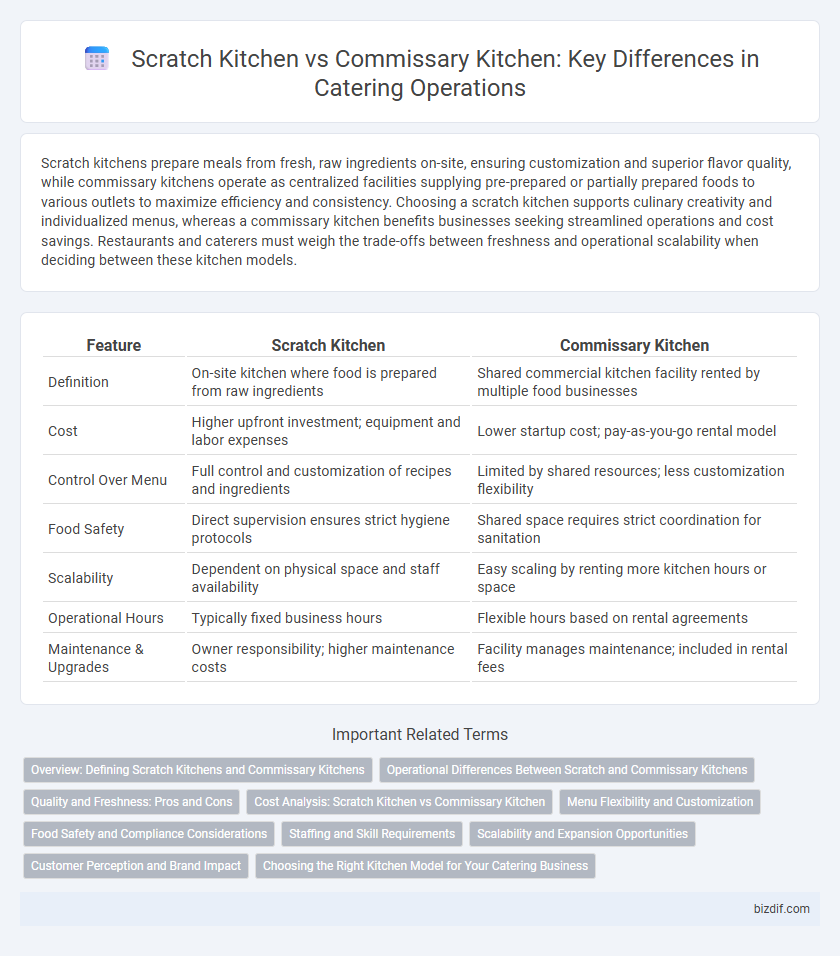Scratch kitchens prepare meals from fresh, raw ingredients on-site, ensuring customization and superior flavor quality, while commissary kitchens operate as centralized facilities supplying pre-prepared or partially prepared foods to various outlets to maximize efficiency and consistency. Choosing a scratch kitchen supports culinary creativity and individualized menus, whereas a commissary kitchen benefits businesses seeking streamlined operations and cost savings. Restaurants and caterers must weigh the trade-offs between freshness and operational scalability when deciding between these kitchen models.
Table of Comparison
| Feature | Scratch Kitchen | Commissary Kitchen |
|---|---|---|
| Definition | On-site kitchen where food is prepared from raw ingredients | Shared commercial kitchen facility rented by multiple food businesses |
| Cost | Higher upfront investment; equipment and labor expenses | Lower startup cost; pay-as-you-go rental model |
| Control Over Menu | Full control and customization of recipes and ingredients | Limited by shared resources; less customization flexibility |
| Food Safety | Direct supervision ensures strict hygiene protocols | Shared space requires strict coordination for sanitation |
| Scalability | Dependent on physical space and staff availability | Easy scaling by renting more kitchen hours or space |
| Operational Hours | Typically fixed business hours | Flexible hours based on rental agreements |
| Maintenance & Upgrades | Owner responsibility; higher maintenance costs | Facility manages maintenance; included in rental fees |
Overview: Defining Scratch Kitchens and Commissary Kitchens
Scratch kitchens emphasize preparing meals from raw, fresh ingredients on-site, ensuring high-quality flavor and customization. Commissary kitchens function as shared commercial spaces where multiple catering businesses rent kitchen facilities, enabling cost efficiency and compliance with health regulations. Both kitchen types play crucial roles in the catering industry by addressing different operational needs and scaling options.
Operational Differences Between Scratch and Commissary Kitchens
Scratch kitchens prepare all menu items from raw ingredients on-site, ensuring full control over ingredient quality and customization. Commissary kitchens operate as centralized facilities where food is prepped in bulk and then distributed to multiple locations, optimizing efficiency and reducing overhead costs. Operationally, scratch kitchens require more skilled labor and inventory management, while commissary kitchens emphasize streamlined workflows and scalability.
Quality and Freshness: Pros and Cons
Scratch kitchens prioritize quality and freshness by preparing meals from raw ingredients onsite, ensuring full control over flavor and ingredient integrity. Commissary kitchens offer consistency and efficiency but may face challenges in maintaining peak freshness due to bulk preparation and longer storage times. High-quality catering thrives in scratch kitchens, while commissaries excel in volume and cost-effectiveness.
Cost Analysis: Scratch Kitchen vs Commissary Kitchen
Scratch kitchens require higher upfront investment in equipment and space, increasing initial capital expenditure, while commissary kitchens offer cost-efficient shared facilities reducing fixed costs. Operating expenses for scratch kitchens include variable costs for raw ingredients, utilities, and labor, often resulting in higher per-meal costs compared to commissary kitchens that benefit from bulk purchasing and resource sharing. Commissary kitchens also provide scalable options and lower maintenance expenses, making them a financially viable choice for startups and catering businesses aiming to optimize budget allocation.
Menu Flexibility and Customization
Scratch kitchens offer unparalleled menu flexibility and customization, allowing chefs to create dishes from fresh, high-quality ingredients tailored to specific dietary preferences and seasonal availability. Commissary kitchens, while efficient and cost-effective, often have standardized processes that can limit the extent of menu innovation and personalized options. Leveraging a scratch kitchen enables catering services to adapt quickly to client needs and deliver unique, customized culinary experiences.
Food Safety and Compliance Considerations
Scratch kitchens require strict adherence to food safety protocols, including thorough ingredient sourcing and real-time preparation hygiene, while commissary kitchens benefit from centralized sanitation measures and standardized procedures to ensure compliance. Regulatory agencies often mandate regular inspections, temperature control monitoring, and staff training in both setups to prevent contamination and foodborne illnesses. Maintaining documented safety practices and proper certification is essential in meeting health codes for both scratch and commissary kitchen operations.
Staffing and Skill Requirements
Scratch kitchens demand highly skilled chefs proficient in preparing meals from raw ingredients, requiring extensive culinary training and experience to maintain quality and consistency. Commissary kitchens allow for streamlined staffing with specialized roles focused on assembling and reheating pre-prepared ingredients, reducing the need for advanced culinary skills. Staffing in scratch kitchens tends to be larger and more versatile, while commissary kitchens benefit from a smaller, more task-specific workforce.
Scalability and Expansion Opportunities
Scratch kitchens offer greater scalability and expansion opportunities due to their in-house control over ingredient sourcing and menu customization, enabling rapid adjustments to customer demand and market trends. Commissary kitchens provide cost-effective shared resources but often face limitations in operational flexibility and menu innovation, which can hinder sustainable growth. Businesses aiming for aggressive expansion typically prefer scratch kitchens for their adaptability and ability to maintain consistent quality at scale.
Customer Perception and Brand Impact
Scratch kitchens are often perceived by customers as delivering fresher, higher-quality meals, enhancing a brand's reputation for authenticity and culinary craftsmanship. Commissary kitchens, while efficient and cost-effective, might be seen as less personalized, potentially impacting the brand's image as mass-produced or less artisanal. Customer perception heavily influences brand loyalty, making the choice between a scratch or commissary kitchen critical for catering businesses aiming to differentiate themselves in a competitive market.
Choosing the Right Kitchen Model for Your Catering Business
Choosing the right kitchen model for your catering business depends on factors like budget, scale, and flexibility. A scratch kitchen offers full control over ingredients and menu customization, ideal for quality-focused, artisanal catering services. In contrast, a commissary kitchen provides shared resources and compliance with health regulations, making it cost-effective for startups and businesses seeking scalability.
scratch kitchen vs commissary kitchen Infographic

 bizdif.com
bizdif.com